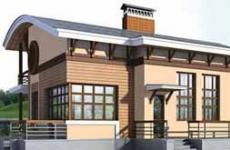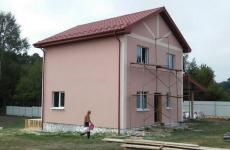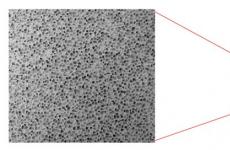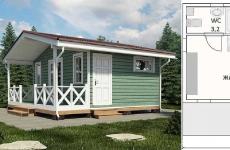Project documentation (what is included). Sample documentation Architectural passport of the project
1. We certify the following documents with a notary (each in triplicate):
* Certificate of State registration of ownership of the land;
* cadastral plan of the land plot.
2. We take notarized copies of these documents (from clause 1.) and original documents. We apply to the administration of the rural district with a statement (in free form) addressed to the head of the administration (example text: “I ask you to allow me to build a house on a land plot that belongs to me by right of ownership”). Within 10-14 days we receive from the local administration a set of the following documents:
* building permit;
Note: This is not yet the document that gives you the right to build a country house.
* application of the local administration;
* certificate of the local administration on the absence of arrests and prohibitions on the land;
* situational plan certified by the local administration;
3. Having collected the received documents, we submit an application to the Department of Architecture and Urban Planning (UAIG), in the name of the acting (check in your area) chief architect of the area. We get a direction to conduct a topographic survey of the site, or we raise a drawing of the site from the cadastral chamber.
4. We get the BTI technical passport.
On the received drawing (scheme of the planning organization of the land plot), we make an agreement with the services:
* Gas service;
* Electricity grid;
* Rostelecom".
As well as:
* We obtain the written consent of the co-owners of the house (if any), certified by the local administration or notarized;
* Enclose a copy of your personal passport;
* In case of violation of building codes (if the distance between houses is less than 15 meters), we obtain the written consent of the owners of neighboring plots, certified by the local administration or notarized.
5. We order a project (architectural and planning solution) of the construction object. You can order the production of a house project in any organization that has a license to carry out this type of work, including the Department of Architecture and Urban Planning (UAIG). The cost of work on drafting a house project is 200 rubles per 1 sq.m. house area.
6. We receive a building passport (project of a house) which contains the following documentation:
A copy of the license of the design organization;
Explanatory note (includes information about the location of the object, the architectural, construction and structural design of the building; a description of electrical equipment, water supply systems, sewerage, heating, ventilation, treatment facilities (if any); a list of fire prevention measures, environmental protection measures; technical and economic project indicators);
Scheme of the planning decision of the land plot;
Explication of premises;
Sketches of the facades of buildings (residential, guest house, etc.);
Basement plans, foundations, floors, attics, ceilings, roofs;
Longitudinal and transverse sections of the building.
7. On the basis of a building passport (house design), we obtain a “building permit” signed by the deputy head of the administration of the municipal district.
The building permit is issued in triplicate. Two of them are issued to the developer, the third remains in the archives of the local government
A project passport is required to obtain a building permit and register a house with government agencies. All the necessary information is in the project, but the local Administration will not accept the project for these purposes, but will require a passport - a document containing some drawings from the project.
You can draw up a passport yourself, but for this you have to go through the entire project, isolate the necessary data from it, copy it and file it into a separate album. There is another problem - a self-made passport may not be accepted by the Administration, since its sheets will not have a live seal of the project developer.
We recommend ordering a project passport to simplify registration and obtaining a building permit immediately with the project. This will help save a lot of time, effort and nerves - we will collect a passport strictly on the basis of the requirements of government agencies and put a live seal and signatures on each of its sheets.
What does the project passport for registration include
Facades with height marks

Plans of all floors with dimensions of the house

Roof plan

Sections with elevation marks

Explanatory note
What is required from the customer
- Project number for which a passport is required
- Name of the customer and address of delivery of the passport
- Your contact number for prompt communication
The cost of a house project passport is 3,000 rubles.
The project passport without ordering the documentation of the project itself is not for sale.
What the customer receives
If necessary, we can send an electronic version of the passport to the specified e-mail.

The term for the production of a project passport is 1 working day.
Why is it profitable to order a passport from us
- We have been designing houses of varying complexity since 2006, we have extensive practical experience in the professional field. The average experience of specialists is 12 years.
- Our employees have higher education in their field and regularly improve their skills. They clearly know the current legislation, so all documents are guaranteed to be accepted by government agencies.
- We offer a strictly individual approach - each customer is assigned a specific specialist who always stays in touch. We take into account all wishes, we advise for free.
- We work without intermediaries, so we excluded any additional markups and overpayments for our customers. We offer the most favorable cost for drawing up a project passport for registration.
How we are working
You provide us with all the necessary data by contacting us by phone, email or messenger - WhatsApp, Viber, Telegram.
Our specialist clarifies the received data, finds the project by its number. If the passport is ordered together with the project, this significantly speeds up and simplifies the process.
If necessary, the specialist provides you with detailed consultations, takes into account all your instructions and wishes.
We get to work and prepare a project passport.
The finished passport is sent by courier service. If necessary, its electronic version is sent to e-mail.
You pay for the service in any convenient way - both from an individual and from a legal entity, in cash to a courier or at our office, by transfer to a card or Sberbank account.
The specialist who worked with you remains in touch even after the completion of cooperation - you can always contact him and ask questions.
How to order a project passport for registration
To place an order for a project passport for registration, use the order form or contact us in any convenient way - write to e-mail [email protected], call +7-999-028-18-57 or use the messenger.
If the passport is ordered simultaneously with the project, nothing is required of you - in this case, our specialists will immediately have access to the necessary documents. However, we will still clarify some of the main points with you, because our task is to make your passport so that it is guaranteed to be accepted from you.
This service greatly facilitates the registration and approval of construction in the Administration.
A house project is a documentation that specifies all the parameters of a building. The documentation will help to imagine how the building will look from the outside and from the inside, how much and what materials will be needed for construction. Sometimes the house project includes additional sections that help to approach the construction in more detail - determine in advance the type of communications to be laid, plan a fire or burglar alarm device at the construction stage. Documentation will be needed both during the construction process and upon acceptance - for quality control and compliance with standards.
What does the project consist of? What items are required?
A standard project is a set of drawings required for construction. The project should have the following sections:
- architectural (AR)- describes general information, architectural solutions, contains floor plans, facade drawings and main sections, roof plan, lists of door and window openings;
- constructive (KR)- includes design drawings of the foundation and other supporting structures, flooring, truss system. In the constructive section, the required building materials and their quantity are indicated.
Such a set of drawings is always included in the design of the house - this is regulated by state regulations. At the request of the customer, additional sections are included in the project documentation - for example, a set of drawings of engineering systems.
In private housing construction, when small residential buildings are being built, they are often limited to a draft design. But this is the first stage of architectural design, it cannot be called complete. The draft documents contain only general data, images of facades and floor plans.
Full design with a more detailed architectural part is preferable: even in the construction of simple buildings there are nuances and design features.
Detailed composition of the project
Architectural and construction solutions (AS)
Project documentation is provided on paper in A3 format, in one copy, certified by a blue seal. The project includes two sections: AR (architectural solutions) and KR (constructive solutions).
Working drawings of the brand AR (Architectural solutions)
This section is divided into several parts:
- general data about the object and an explanatory note;
- master plan;
- center plan of axes;
- masonry and marking plans;
- each of the facades of the house with an indication of elevations;
- roof plan;
- main cuts around the house;
- explication of floors, features of filling the openings of windows and doors;
- ventilation ducts and chimneys.
The architectural drawings indicate the location of all windows, doors, ventilation shafts, fireplaces with chimneys, the height of the floors, the thickness of the walls; shows the main structural units.
Project documentation
1. Project cover
2. Title page

3. General data of the project and specification of the main material of the walls of the house


4. Measured floor plans (construction)



5. Marking floor plans




7. Cuts




9. Facades






12. Fragments of the plan

13. Ventilation ducts, chimneys



Working drawings of the brand KR
This section as part of an architectural project is developed for the technically competent implementation of architectural ideas. The CR consists of the following parts:
- common data;
- foundation layout, including dimensions, exact location on the site, laying depth;
- floor plan, lintels, truss structure with dimensions and technical instructions for the device;
- detailed drawings;
- calculation of the consumption of masonry materials;
- material specifications.
The composition of the drawings included in the CD depends on the type of structures included in the design documentation.
Example: Structural solutions, as part of QOL and KD
The composition of the QOL section (reinforced concrete structures)
1. General data


2. Foundation plan, material specification






4. Monolithic columns (if any according to the project), specification


5.Porch

6. Floor plan with specifications






7. Jumper layouts, specification






8. Monolithic belts, specification




The composition of the CD section (wooden structures)
1. General data





Additionally:
Engineering systems (IS)
If, in addition to the main sections, which the project of the house necessarily includes, a section of engineering networks is provided, it should contain the following parts:
1. general explanations for each of the life support systems, recommendations for installation and connection of devices;
2. scheme of water supply, sewerage systems - rationale for the choice - individual or with connection to centralized systems, - floor plans;
3. heating scheme - substantiation of an individual heating device or connection to central networks, heat engineering calculation;
4. power supply design, including network wiring diagrams, electrical wiring, electrical equipment layout plans ( ;
5. specification of products, equipment, materials. ( Ordered for each project separately, at the request of the customer.)
For some projects, standard ICs have been developed, check with the manager for their availability. Their cost is not included in the AC project price.
Examples:
Architectural Passport
The passport for the project of the house is not included in the complete set, it can be purchased for an additional fee.
The architectural passport of the project makes it faster and easier to obtain a building permit, as it contains all the documents necessary for submission to the local architecture authorities.
The composition of the architectural passport:


Plans in axes




facades
Axis cuts






The sale of the "Construction passport of the project" without the acquisition of the main set of working drawings is not carried out.
You can also purchase an additional set of drawings (paper copy), which, as a rule, is necessary for builders.
Can I make changes to pre-made sections?
You can make changes to any finished project, but you need to evaluate profitability: if the changes affect the construct, the finished calculations will not be relevant. And the cost of the finished project, taking into account the changes made, may be higher than the development of an individual one from scratch.
In modern Russian conditions, the construction of a private house is a lengthy procedure, not only due to technological complexity, but also for another reason, the name of which is bureaucracy. At the same time, the need for coordination of architectural projects in the competent authorities cannot be denied, however, the very mechanism of coordination, which we inherited as a Soviet legacy, is so intricate that “without half a liter” only knowledge of the relevant legislation, one’s rights and obligations will allow one to understand it.
The fundamental normative act in the field of construction and architecture is the Town Planning Code of the Russian Federation. In particular, this codified law regulates legal relations and delimits the responsibilities of various authorities regarding territorial planning, technical regulation of urban planning, state expertise of relevant projects and state construction supervision. However, in order to boldly enter the offices of officials, knowing their duties and their rights, it is necessary to study a larger amount of regulatory information.
Many owners of land plots who are planning the construction of an individual residential building, having read paragraph 3 of Article 48 of the Town Planning Code of the Russian Federation, which states that the preparation of project documentation for individual low-rise housing construction is not required, do not consider it important the procedure for detailed development and approval of the project.
However, in reality, this norm of legislation only misleads developers, because the Code of Design and Construction Rules “Development, coordination, approval, composition of design and planning documentation for the development of low-rise housing construction territories” (SP 11-111-99) supplements the requirements of paragraph 3 tbsp. 48 of the Town Planning Code, establishing, among other things, a list of documents that are necessary for the construction to be legal. At the same time, the norms of SP 11-111-99 do not directly contradict the norms of the Urban Planning Code, which excludes the possibility of invalidating them.
Any construction begins not even with an architectural project, but with the purchase of a land plot.
At the same time, it is worth remembering that within the city, any construction is carried out in accordance with urban planning documentation, therefore, for individual low-rise construction, only the land plot that, according to the territorial development scheme of the settlement, its urban planning documentation and other acts of the administration of the subject of the Federation and local governments, is allocated as area for low-rise construction.

Information regarding vacant land plots and their purpose can be obtained from the local council. If we talk about suburban areas, then any such plot of construction purpose can be used for individual construction.
Articles 7 and 8 of the Town Planning Code will help you figure out which authorities are competent in matters of allocating land plots, as well as issuing building permits on these plots and putting the constructed facilities into operation: local governments of settlements and municipal districts are authorized in the above issues if we are talking about sites and facilities on the territory of settlements and municipal districts, and in the case of suburban areas, it is necessary to contact local executive authorities.
In accordance with the Code of Rules SP 11-111-99, construction on a certain site is possible only after it has been geodetic offset and fixing its borders on the ground according to the survey project. These activities are carried out by numerous private companies and individuals who have the appropriate licenses. The implementation of these actions is formalized by the act of acceptance and transfer.
According to clause 4.2 of SP 11-111-99, it is necessary to start developing project documentation with resolution of the local executive authority on permission for construction or design. You will also need approval of the choice of land. Project of a house, the area of which exceeds 500 sq. m., should be developed in accordance with architectural and planning task, an application for which is submitted to the architecture committee of your area. The architectural and planning task includes about two dozen points, the requirements of which are the basis for the development of the project (natural conditions, architectural requirements, land improvement, etc.).
The object of individual development is issued by the local executive authority. It is necessary to apply to the department (management) of architecture and urban planning. The chief architect of the city or district is authorized to certify the permit, and it is approved by the Head of the local administration. A building permit is issued on the basis of an application to which title documents are attached (decree on granting a plot for individual housing construction, an agreement on granting building rights), a master plan of a land plot, a passport of a land plot, a passport of a house project, an act on establishing the natural boundaries of the plot and breakdown of buildings, axes and red lines of the building. If the construction company is directly involved in the coordination, a license for the right to construction activities must be added to the package of documents.

Architectural project passport an individual residential building required for obtaining a building permit is ordered from any organization that has a license to provide such services. The architectural passport must necessarily include a roof plan, floor plans, colored facades, sections along the axes and facades along the axes, accompanied by a general explanatory note. A copy of the project developer's license must also be included in the architectural passport of the project.
As you can see, the design and approval processes are interconnected and it is most rational to carry them out in parallel, as far as possible, because the same architectural passport is easiest to order from the project developer, in addition, in order to obtain a building permit, you must have basic design materials such as floor plans, facade plans, etc.
Services for the development of private house projects today are provided by many organizations. Design work is carried out on the basis contract-order for the execution of project documentation. You should never neglect the drafting of such an agreement, since it can become your main guarantee and the main argument in case of claims against the project developer. The contract-order for the execution of project documentation indicates information about the parties: personal data of the customer (full name, address of residence, series and passport number) and the name of the organization in which the design work is ordered, and / or full name and details of the direct project executor. According to the contract, the contractor undertakes to complete the project in accordance with all SNiPs (building codes and regulations) and GOSTs (state standards) and issue it to the customer in the stipulated number of copies, and the customer undertakes to pay for the design work before they begin and appear for interim project approvals and accept its final version.
Already at the stage of concluding an agreement for the implementation of project documentation, you must finally decide whether you want to entrust the approval of the project to its developer or go through fire, water and copper pipes of all instances on your own. This choice is unlikely to be easy for you - coordination services are very expensive, and in order to legitimize the project and construction on your own, you will need a lot of time and effort, and most importantly - knowledge (we hope that in terms of knowledge this article will be useful to you in particular). If you decide to order project approval services from the developer, then this must be indicated as a separate clause in the contract, listing the bodies in which the developer undertakes to coordinate the project. Also an important condition of the contract is the obligation of the contractor to eliminate at his own expense all the shortcomings of the project that arose through his fault. First of all, we are talking about the comments of the coordinating authorities, which relate to various omissions in the project, for example, its inconsistency with certain regulatory documents. In addition, it is necessary to determine in the contract which of the parties undertakes to approve the project from the chief architect of the city or district. The contract signed by the parties must be agreed with the head of the department (department) of urban planning of the local administration.
After the conclusion of the contract for the implementation of project documentation, a design assignment a private residential building and, if necessary, outbuildings. Based on this task, the contractor will develop a project. The task indicates the basis for the design (contract for the implementation of project documentation), the stage of project development; number of storeys, area and other main characteristics of the future home; Your requirements for constructive, engineering and architectural and planning solutions, as well as for the improvement of the entire land plot. After you approve the task, it must be coordinated with the department (department) of architecture and urban planning in your city/district.
After that, the executing organization within the stipulated time develops a project, which must comply with the norms of the Town Planning Code of the Russian Federation, Decrees of the Government of the Russian Federation, as well as sets of rules (SP) and a lot of SNiPs and GOSTs, including:
- "On the composition of sections of project documentation and requirements for their content"
- "On engineering surveys for the preparation of project documentation, construction, reconstruction of capital construction projects"
- "On approval of the rules for the submission of project documentation for objects, construction, reconstruction, overhaul of which is supposed to be carried out on the lands of specially protected natural areas for state expertise and state environmental expertise"
- "Planning and development of territories of low-rise housing construction"
- SNiP 2.01.15-90 "Engineering protection of territories, buildings and structures from hazardous geological processes"
- SNiP 3.05.04-85 "External networks and water supply and sewerage facilities"
Finished project consists of many documents, including a situational plan, a topographic survey of a land plot and its master plan, plans for a basement, basement or technical underground, floor plans, plans for facades, ceilings and coverings, characteristic sections, a plan for the roof truss system, a foundation plan with its sections and characteristic nodes and details, drawings of engineering networks, as well as an explanatory note and main technical and economic indicators. In addition, the design documentation may include a construction estimate, but in practice a detailed estimate is ordered from the contractor not so often due to its high cost.
Individual requirements for your project will be presented sanitary and epidemiological, fire inspection and the Ministry of Emergency Situations, therefore, the project will be coordinated in these bodies.
For connection to various engineering networks(electricity, water supply and sanitation) are necessary specifications issued by the relevant utilities. The procedure for issuing technical conditions is regulated by the regulations of local governments.
To move from the design stage to the construction stage of an individual residential building, it is necessary submit a complete package of finished project documentation to local architecture authorities, after which the same bodies, headed by the chief architect of the district, begin to prepare a permit, which is approved by the head of the local administration. You are obliged to transfer one copy of the final design documentation to the local architecture committee for storage, about which an appropriate act is drawn up.
Remember that if you deviate from the requirements of the law when developing and agreeing on the project of an individual residential building, there is a risk that the future home will be recognized as a “self-construction”, which can lead to significant fines and even the dismantling of the building. But even this administrative responsibility does not eliminate civil law consequences, which can only be corrected by the subsequent proper registration of the project and the construction site. By civil law consequences is meant the inability to carry out any legal action regarding "illegal" real estate, from sale to will.
You can order and buy an architectural passport for a house project of an individual residential building at any design organization that has a state license to provide services of this kind. The package of documents of the architectural passport must necessarily include roof and floor plans, sections along the axes, colored facades and facades along the axes, which must be accompanied by a general explanatory note.
Remember to ensure that a copy of the project developer's license is included in the project passport.
The design and approval processes are closely interrelated, so it is desirable to carry them out in parallel whenever possible. It is easiest to order an architectural passport from the company that designs your house, as they will immediately provide you with all the necessary plans and documents.
Design work is carried out on the basis of a contract-order for the preparation of project documentation. Experts recommend not neglecting the signing of this agreement - if there are claims against the project developer, it can become your main guarantee and the main argument in the dispute.
Documents for registration
To obtain an architectural passport for a country house, you will need a license for the right to build activities and a contract for building a house, project documentation for the construction, permission from the administration for construction and an architectural and planning assignment.
In addition, do not forget to include in the package of documents a certificate of ownership of the land, a task for the design of a residential building and outbuildings, a situational plan in the form of a topographic survey with applied communications, and conditions for connecting to engineering networks. It is also necessary to provide a copy of the relevant urban planning documentation from the master plan, the result of engineering and geological surveys, the act of establishing the boundaries of the site or the breakdown of buildings, and the architectural passport itself.
It is possible to install devices, equipment and engineering communications only after the completion of construction and compliance with all standards.
The connection of gas, light, electricity, heating and sewerage to the general networks occurs after the provision of project documentation. You will also need a special approval, which you will receive after checking the compliance of the house with the current sanitary norms and rules.






